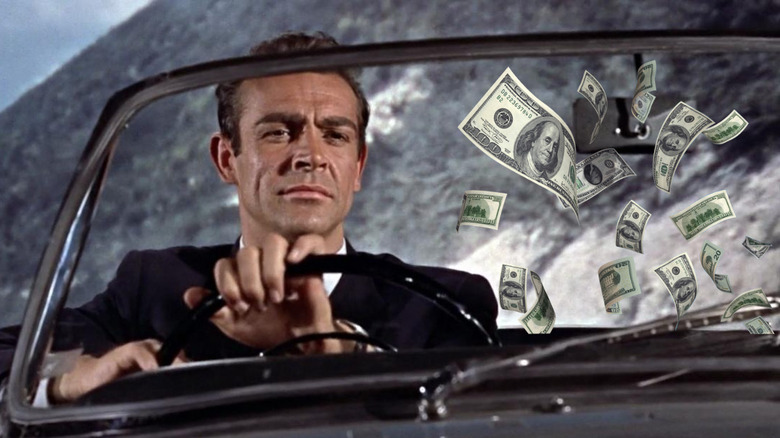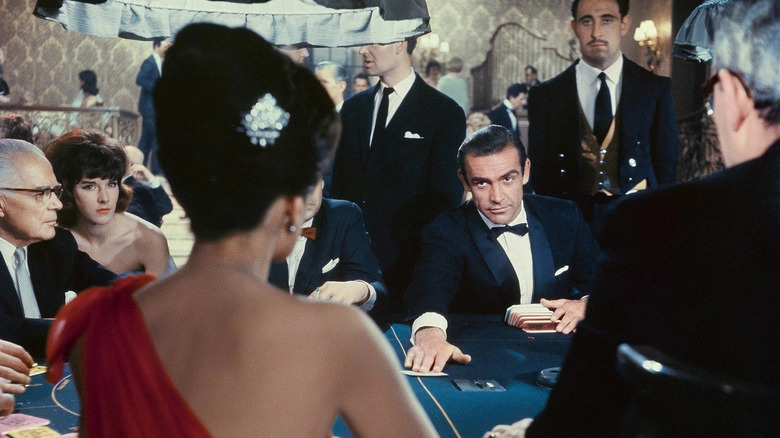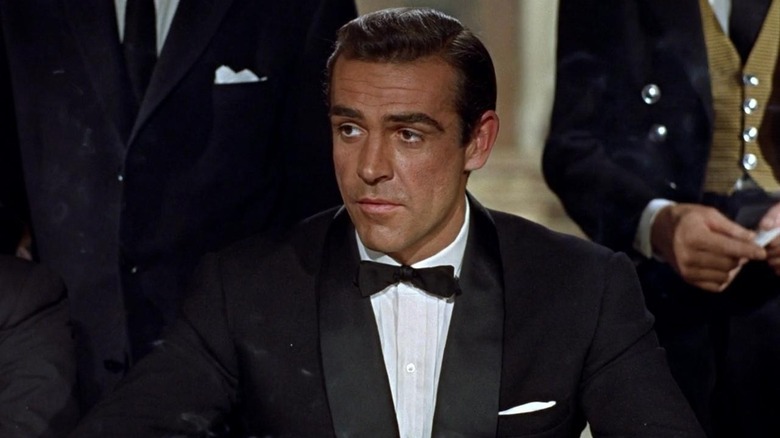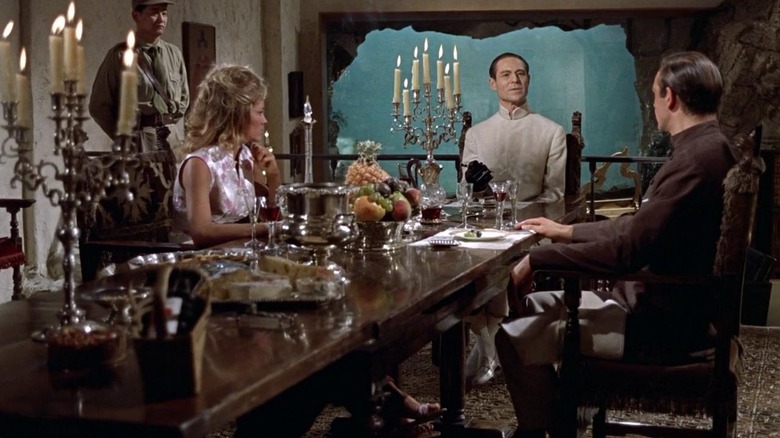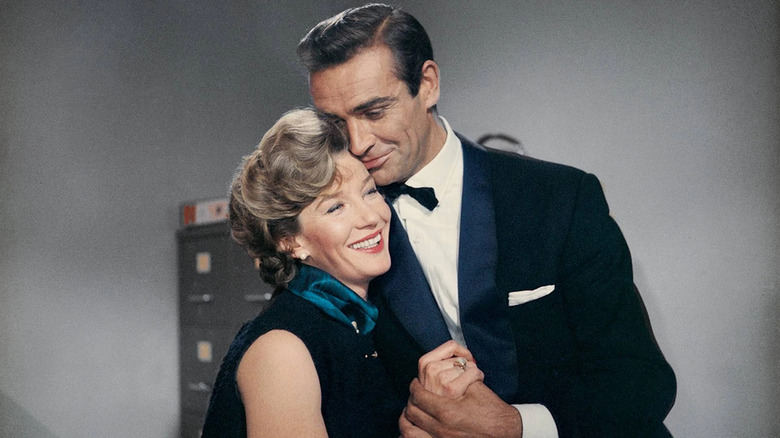Tales From The Box Office: Dr. No Kicked Off Cinema's Most Enduring Franchise With Bond, James Bond
(Welcome to Tales from the Box Office, our column that examines box office miracles, disasters, and everything in between, as well as what we can learn from them.)
It is extremely difficult to make a movie of any kind. Talk to any director or read any interview with anyone who has made a motion picture before. Nobody ever paints the process as a breeze. Harder still is to make a good movie, and one that goes on to find its audience. The seemingly impossible? Making a franchise that endures for multiple generations and through multiple incarnations. Yet, that's precisely what the "James Bond" franchise has done, having endured for a full six decades in the public consciousness of moviegoers around the world.
While the journey started with author Ian Fleming who was himself in the British Secret Service and wrote something of a fantasy spy thriller in the form of "Casino Royale," which was published in 1953, it was nearly a decade later that 007 became a pop culture icon when "Dr. No" (based on the sixth novel in the series) hit theaters in 1962. Sean Connery brought Fleming's creation to life and, broadly speaking, the world has never looked back on some 25 movies and billions at the box office later.
In honor of the 60th anniversary of "Dr. No," we're going to look back at how Bond made the leap from the page to the screen, how an unknown actor cemented the MI6 agent as one of the all-time icons of cinema, and what lessons we might be able to extract from the film's success all these years later. Let's dig in, shall we?
The movie: Dr. No
As recounted in the documentary "Everything or Nothing: The Untold Story of 007," Fleming was a bit unsure of what to do with himself after leaving active service in the British military. But during the Cold War, Fleming was inspired to write "the spy thriller to end all spy thrillers," which he did so at his getaway at Goldeneye in Jamaica. It is clear based on James Bond's description in "Casino Royale," when coupled with Fleming's life experience, that Bond was, more or less, the author's alter ego. But where exactly did the name come from? A book about birds, it turns out.
"When I started to write these books, I wanted a really flat, quiet name. And one of my bibles out here is James Bond's Birds of the West Indies. I thought, 'Now James Bond. That's a really quiet name.' So, I simply stole it and used it."
While the books sold well (despite some critical lashing due to the content) Fleming always saw Bond as suited to movies, but Hollywood had a tough time getting on his wavelength. The original attempt, 1954's "Casino Royale" with Jimmy Bond as a TV movie, turned the British spy into an American. Then, Albert "Cubby" Broccoli came into the picture, and thus began one of the most important cinematic ventures in history. Not to overstate it or anything.
Broccoli made escapist features largely in Britain, such as "Fire Down Below." These pictures put Cubby on the map but the key thing is that he was actually a fan of Fleming's "Bond" books. As was Harry Saltzman, a former entertainer from the circus world who actually paid Fleming to get the rights to the books. But Saltzman lacked Hollywood connections and, as his option was set to expire, meaning the rights would lapse, a fateful meeting was in the cards. Cubby came into the picture through mutual friends. Using his connections, they formed a company called EON, which actually meant "everything or nothing," to finally bring Bond to the big screen.
But what about a distributor? Ultimately, EON cut a deal with United Artists, but it was only because someone else passed up on what would become a golden opportunity, as David Picker of United Artists explained.
"First place was Columbia, because that was Cubby's home. They turned him down. And then United Artists got a phone call from Cubby and Harry saying they wanted to meet with us. So, we faced each other. They said we had to spend somewhere over $1 million, and in those years that was a serious budget. It was a risk. That was a big moment for me, an enormous decision. We said okay."
Sean Connery becomes 007, with some pushback
Roughly speaking, accounting for inflation makes things ten times more expensive in today's dollars when compared to 1961. So, that $1 million was really like $10 million. And mind you, this was long before Hollywood productions ever approached the $100 million numbers they do today. That big investment was going to have to rest on the shoulders of a star in the title role. United Artists had envisioned an American star as Bond, but it was a relatively unknown Sean Connery who was eyeing the role. Fleming disliked the choice initially and the studio pushed back.
"Normally, the question from the distributors is, who is gonna play him? Cary Grant? Or James Mason? When you surprise them by telling them you want an unknown, they were not entirely sold," Broccoli said at the time. Ultimately, as legend has it, in tests women responded extremely well to Connery's gruff, man's man exterior, which sold the deal. And so, that ideal of the man men wanted to be and also the man that women wanted to be with was found in an actor who, at the time, was perhaps best known for starring in movies like "Tarzan's Greatest Adventure."
To guide Connery on this journey in bringing "Dr. No" to the big screen, director Terrence Young, known for war films such as "Paratrooper" and "Storm Over the Nile," was selected to take the helm. But it was, perhaps, the selection of Ken Adam as production designer, that would be the biggest of big decisions, as he would ultimately craft the look and feel of Bond that we've come to associate with the franchise to this day. Adam became a mainstay of the series but getting it right in this first go-around was ever so crucial.
"The budget for Dr. No was under $1m for the whole picture. My budget was £14,500. I filled three stages at Pinewood full of sets while they were filming in Jamaica. It wasn't a real aquarium in Dr. No's apartment. It was a disaster to tell you the truth because we had so little money," Adam once said speaking with The Guardian. Be that as it may, he made it work like gangbusters, while Young proved to be the perfect man behind the camera, and Connery, it turned out, would almost instantly become an all-timer of a cinematic icon.
The financial journey
While "Dr. No" wouldn't ultimately make it to North American theaters until May of 1963, it was on October 5, 1962, that audiences in the U.K. got their first taste of Bond, James Bond. Audiences were instantly enthralled with this ladies' man super spy. The violence. The gambling. The suits. The cars. The sex. It all made for an equation quite unlike anything cinema had brought us before. The phrase "overnight sensation" is arguably a bit overused but, in this case, it feels warranted.
Ultimately, the film would gross $59.5 million globally and, again, if we account for inflation, that figure grows to around $583 million. Or, to put it another way, just shy of 60 times its production budget. A smash hit if ever there were such a thing. Bond was a sensation and, thankfully, Fleming had a whole lot of source material to mine for further stories, paving the way for a franchise that could go on for years to come. Connery's run would end officially with "Diamonds are Forever," after surrendering the role briefly to George Lazenby for "On Her Majesty's Secret Service."
Connery carried the torch for just shy of a decade but the likes of Roger Moore, Timothy Dalton, Pierce Brosnan, and Daniel Craig would also keep the flame burning over the ensuing decades in everything from "You Only Live Twice" to "Skyfall." This was merely the beginning of the most enduring franchise in cinematic history. All told, the 25 official films in the "James Bond" canon have grossed $7.87 billion globally, generating untold millions (if not billions) in merchandising and other revenue streams along the way.
The lessons contained within
The story of "James Bond" as a cinematic success, ultimately, boils down to passion at every turn. Ian Fleming had a passion for his creation and was determined to see him brought to life faithfully on screen. Cubby Broccoli and Harry Saltzman both adored Bond and had the vision to see him leap to life from the page. United Artists understood the potential value of what Fleming had created and was willing to risk a lot of money to make something bigger than your average movie. It's passion and vision that made James Bond a household name, and that's what has kept that name relevant for six decades and counting.
Largely, that same passion and vision that made "Dr. No" a smash success in its day has endured, allowing films like "Goldfinger," "The Spy Who Loved Me," "Goldeneye," and "Cassino Royale," among many others, to become hits across multiple decades. It's remarkable how few straight-up misfires (from a financial perspective) this series has suffered. So, how has "James Bond" accomplished what seemingly no other franchise has? To me, it all comes down to a willingness for reinvention while somehow keeping the heart of the property intact.
Having a handful of actors take up the mantle of 007 after Connery, most of them to great success, is like having five guys play Wolverine or Iron Man over the course of 60 years without ever having much of a lull at the box office. It's downright difficult to picture. The lesson? Let things evolve. Don't let the property at hand become a sexist, misogynist dinosaur and a relic of the Cold War. If something is to endure, it must also adapt without forgetting what made it special in the first place. Easier said than done, I grant you, but that is why we don't have many other 60-year franchises to use for comparison.
